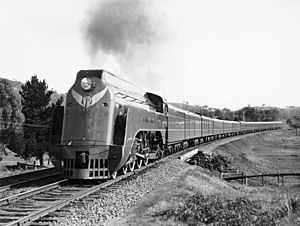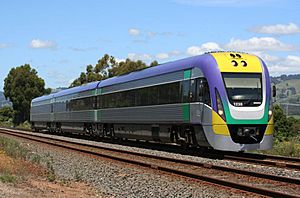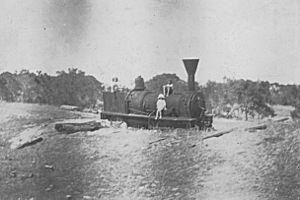History of rail transport in Australia facts for kids
Australia's railway story began in the 1850s. At first, people thought private companies would build the railways. In Victoria, the first private railway opened in 1854. In New South Wales, a private company started building, but the government took over in 1855 because the company went broke.
South Australia's railways were owned by the government from the start. They had a horse-drawn line in 1854 and a steam-powered one in 1856. In Victoria, private railways didn't make enough money, so the government took them over too. Government ownership helped build railways to develop new areas, even if they weren't immediately profitable.
The very first railway in Australia opened on 10 December 1831. It was in Newcastle, New South Wales, and was owned by the Australian Agricultural Company. This private railway used a special sloped track to move coal from the "A Pit" mine.
A big problem was that the different colonies built railways with three different track widths, called "gauges." This became tricky when lines met at Albury in 1881 and Wallangarra in 1888. In the 1900s, main lines between big cities were changed to a "standard gauge." Also, electric train networks were built in cities like Sydney, Melbourne, Brisbane, and Perth.
Later in the 1900s, many smaller country lines closed. But new, long railways were built to carry heavy loads like iron ore in Western Australia and coal in Queensland to ports. Some of these are still privately owned.
In the 1990s and early 2000s, the railway systems changed again. The main interstate network came under the control of the Australian Rail Track Corporation. Private companies were allowed to run trains on these tracks for the first time. Some country networks also became privately controlled. Melbourne's city train system was even run by private companies for a while.
Contents
How Railways Grew in Each State
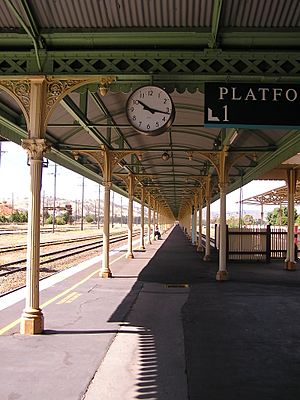
Australia's very first railway started on 10 December 1831 in Newcastle, New South Wales. It was a private line for the "A Pit" coal mine. It used a special sloped track made of cast iron to move coal.
South Australia's first railway was a horse-drawn line. It opened on 18 May 1854, connecting Goolwa and Port Elliot. This helped ships avoid the dangerous mouth of the Murray River. Soon after, the first steam train started running between Sandridge (now Port Melbourne) and Flinders Street in Melbourne.
In 1848, the Sydney Railway Company was formed to connect Sydney with Goulburn and Bathurst. The goal was to transport wool for export. But the company struggled to raise money. The gold rushes in 1851 made things harder by causing a shortage of workers and raising prices. The first part of the line, from Sydney to Granville, finally opened in 1855. The company went bankrupt, and the government took over, creating the New South Wales Government Railways.
Victoria benefited greatly from the gold rushes. Major gold discoveries happened in places like Ballarat and Bendigo. This led to big growth in Melbourne. Australia's first steam-powered city railway opened in 1854, connecting Melbourne to Sandridge (now Port Melbourne). Most Victorian lines used a wider track width called "broad gauge." In 1856, the government-owned South Australian Railways also opened its first broad gauge line from Adelaide to Port Adelaide.
The colonies didn't agree on a single track width. The British Government had advised them to use a uniform gauge, but they didn't listen. New South Wales changed its mind about the gauge a few times. Victoria decided to stick with the broad gauge, and South Australia followed Victoria. This created problems later when the railway lines from different states met.
Queensland's first line opened in 1865 from Ipswich to Bigge's Camp. It used a narrower track width, called "narrow gauge," to save money, especially when building through hills. This narrow gauge was later used in Tasmania and Western Australia.
Tasmania's first broad gauge line opened in 1871, connecting Deloraine to Launceston. It was later changed to narrow gauge in 1888. Western Australia opened its first government-owned line in 1879, connecting Geraldton and Northampton. Railways then spread from these first lines, linking farms and mines to ports.
By the 1880s, the main railway systems of New South Wales, Victoria, South Australia, and Queensland met. However, they had different track widths, meaning passengers and goods often had to change trains. Only Victoria and South Australia shared the same broad gauge, but they still changed engines at the border. Western Australia was far away, separated by a huge desert.
The first "break of gauge" happened when New South Wales and Victorian lines met at Albury in 1883. Victoria and South Australia's broad gauge lines met at Serviceton in 1887. In 1888, New South Wales and Queensland lines met at Wallangara. In 1889, the first line in the Northern Territory opened from Darwin to Pine Creek. In 1914, a short extension from Queanbeyan to Canberra created the Australian Capital Territory's first line.
New South Wales Railways
New South Wales' railways used the standard gauge. They were built to connect Sydney and Newcastle ports to the farming areas inland. The first public railway from Sydney to Parramatta Junction opened in 1855.
The Main Southern line was built in stages from Parramatta Junction to Albury between 1855 and 1881. It connected to Victoria's railways in 1883, but with a different track width. The standard gauge connection from Albury to Melbourne was finally finished in 1962. The Main Western line reached Bourke in 1885.
The Main North line was built over many years. The section from Sydney to Newcastle was completed in 1889. The line from Newcastle to Wallangarra was finished in 1888, also with a break of gauge at the Queensland border.
The Broken Hill line was completed in 1927, connecting to South Australia's railways with another break of gauge. Many smaller branch lines also spread across the state. In 1926, work began to electrify Sydney's city railways and connect them with new lines.
Victoria's Railways
Victoria's first railway was a city line from Melbourne to Port Melbourne in 1854. Other lines soon connected Melbourne to Geelong and the gold rush towns of Bendigo and Ballarat by 1862. In 1864, a line reached the Murray River port of Echuca.
In 1883, Victoria's North East line connected with New South Wales at Albury. This required a change of trains due to the different track widths. In 1887, Victorian Railways met South Australian Railways at Serviceton. Both systems used the broad gauge, so it was easier.
In 1919, Melbourne's city train lines started to be electrified. While some small extensions were made, fewer people used trains as cars became popular from the 1960s. However, in recent years, train use has increased a lot. Melbourne's only underground railway, the City Loop, opened in 1981. Many smaller country lines were closed from the 1950s because they weren't making money. In the 1990s, parts of Victoria's railway network were privatized. Later, the Regional Fast Rail project improved tracks and introduced new trains for regional cities.
Queensland's Railways
Queensland's first railway opened in 1865 from Ipswich to Grandchester. It was built using a narrow gauge to save costs, especially through hilly areas. This was the first time this narrow gauge was used anywhere in the world. It later spread to other places like Western Australia, Japan, and New Zealand.
The line was extended to Toowoomba in 1867 and connected to Brisbane in 1875. From Toowoomba, it reached the New South Wales standard gauge line at Wallangarra in 1887.
Separate lines were also built from east coast ports like Maryborough, Rockhampton, and Townsville railway station. These lines connected inland areas to the coast. The North Coast line, which connects these coastal cities, was finally completed to Cairns in 1924.
In the late 1900s, many heavy-haul coal lines were built from ports like Gladstone and Hay Point. Some of these coal lines were electrified starting in 1986. Brisbane's city train system also became electrified from 1979. The North Coast line between Brisbane and Rockhampton was also electrified. These are Australia's main electrified country railways.
Western Australia's Railways
Western Australia's first railway was a private line for timber. In 1879, the Western Australian Government Railways opened a narrow gauge line to connect the copper mine at Northampton with the port of Geraldton. Later, lines also grew from ports like Fremantle (Perth's port), Bunbury, and Albany, mainly to carry grain and minerals.
The line between Fremantle, Perth, and Guildford opened in 1881. By 1896, the railway connected Perth to Kalgoorlie, where gold had been found in 1893.
In the 1900s, Perth finally connected to the eastern states. In 1917, the standard gauge Trans-Australian Railway linked eastern Australia to the narrow gauge network at Kalgoorlie. Many smaller branch lines were closed from 1957.
Starting in the 1960s, big mining companies built long, heavy-haul railways in the Pilbara region to transport iron ore. New lines are still being built there today. In 1986, Perth's city train lines started to be electrified. A long new line from Perth to Mandurah opened on 23 December 2007.
South Australia's Railways
In 1854, South Australia opened a horse-drawn tramway from Goolwa on the Murray River to Port Elliot. This helped move goods between river boats and ocean ships. This line was later extended to Victor Harbor.
South Australia's first steam train line opened in 1856. It was a broad gauge line between Adelaide and Port Adelaide. This line was extended to the copper mining towns of Kapunda in 1860 and Burra in 1870.
A network of lines spread out from Adelaide and other ports. Many of these were initially narrow gauge lines, built to carry ore, especially copper. The first narrow gauge line was completed in 1870 from Port Wakefield to Hoyleton.
The first connection with another state happened in 1887, when South Australia's and Victoria's broad gauge railways met at Serviceton. In 1888, a narrow gauge line opened from Port Pirie to Broken Hill. This line connected to Adelaide via Peterborough. The broad gauge line from Adelaide reached Terowie in 1880. The line north of Terowie was built as narrow gauge to Oodnadatta by 1891. This line was extended to Alice Springs in 1929 and was called the Central Australia Railway.
Tasmania's Railways
Tasmania's first railway was a broad gauge line opened in 1871 between Deloraine and Launceston. It quickly ran into financial trouble and was taken over by the Tasmanian Government in 1872. In 1876, the Tasmanian Main Line Company opened a narrow gauge line from Hobart to Evandale, near Launceston. This created another "break of gauge."
More confusion happened in 1885 when the government built another narrow gauge line. This was fixed in 1888 when the Launceston–Deloraine line was changed to narrow gauge.
The Tasmanian Government bought the Tasmanian Main Line Company in 1890, creating the Tasmanian Government Railways. Other branch lines were built, but Tasmania's railway system has always been small and often struggled to make money. Today, it's operated by the Tasmanian Government-owned Tasrail.
Building a National Railway Network
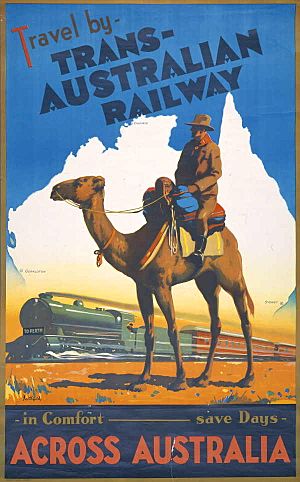
In the 1800s, railways were built to move farm products and minerals to ports for export. They also carried passengers and goods between colonial capitals and regional areas. Most travel and freight between colonies happened by ship. The problem of different track widths became very clear when lines from different states met at Albury in 1883 and Wallangarra in 1888.
When Australia became a federation of states in the 1890s, people discussed if railways should be a federal responsibility. It was decided that states would keep control of their railways. However, the Australian Government can provide money to states for railway upgrades. The Australian Government is fully responsible for railways in federal territories.
In 1910, railway experts decided that the "standard gauge" should be the main track width for Australia. Over many years, plans were made to fix the gauge problem, but most failed because they were too big and expensive.
Creating a Standard Gauge Network
In the 1900s, the different state railway systems started to connect more, but this often created more "breaks of gauge." In 1917, the Federal Government completed the standard gauge Trans-Australian Railway between Kalgoorlie and Port Augusta. However, this still meant changing trains at Kalgoorlie to reach Perth, and at Port Augusta and Terowie to reach Adelaide.

In 1932, progress was made when the standard gauge Sydney–Brisbane railway was completed. This included the opening of the Grafton Bridge. The standard gauge line from Port Augusta was extended to Port Pirie Junction in 1937, removing one break of gauge.
In the 1950s, a plan was suggested to convert three main missing links to standard gauge:
- Albury to Melbourne: A standard gauge track was added next to the existing broad gauge line to complete the Sydney–Melbourne railway.
- Kalgoorlie to Perth: The narrow gauge line was changed to standard gauge.
- Broken Hill to Port Pirie: The narrow gauge line was changed to standard gauge.
In 1962, the standard gauge line from Albury to Melbourne opened, completing the Sydney–Melbourne railway. In 1968, the Kalgoorlie to Perth line was finished. In 1969, the Broken Hill to Port Pirie standard gauge railway opened, completing the Sydney–Perth railway.
The Whyalla line opened in 1972. In 1980, a new standard gauge railway was completed from Tarcoola to Alice Springs, replacing the old narrow gauge line. Adelaide was connected to the standard gauge network in 1982. The Melbourne–Adelaide railway was converted to standard gauge in 1995. The Tarcoola to Alice Springs railway was extended to Darwin in 2004, completing the Adelaide–Darwin railway.
Railways in the 1990s and Today
Private Companies and Railways
In 1992, the National Rail Corporation, mostly owned by the Federal Government, took over interstate rail freight. Its freight operations were later combined with FreightCorp and sold to private companies Toll Holdings and Patrick Corporation in 2002, becoming Pacific National.
Australian National was privatized in 1997. Its Tasmanian operations were sold to Australian Transport Network, which was later taken over by Pacific National. South Australian branch lines were sold to Genesee & Wyoming. Its passenger trains were taken over by Great Southern Railway.
Most state freight and country passenger services were privatized, except in Queensland. City passenger trains usually stayed government-owned because they are important public services and often don't make a profit.
New train companies appeared, including those running wheat trains. Some companies, like Chicago Freight Car Leasing Australia, started leasing locomotives and rolling stock to any company that needed them.
Separating Tracks and Train Operations
Building and maintaining railway tracks became the job of non-profit government bodies. This was done to allow new and existing companies to use the tracks.
The interstate rail network was given to the Australian Rail Track Corporation (ARTC) in 1998. The Tarcoola–Alice Springs line was leased to the AustralAsia Rail Corporation in 2002. The ARTC manages tracks from Kalgoorlie to Broken Hill and Serviceton. It also manages the interstate standard gauge network in New South Wales and Victoria. The ARTC also works with Queensland Rail on the standard gauge line near the Queensland border.
Other railways continue to be managed by their original owners, but they must allow other companies to use their tracks. For example:
- Queensland: Queensland Rail
- Tasmania: Pacific National
- Victorian non-interstate lines: Pacific National
- Western Australian non-interstate lines: Australian Railroad Group
- South Australian non-interstate lines: Genesee & Wyoming Australia
- Darwin-Tarcoola railway: FreightLink
Much of the track maintenance is now done by private companies under contract.
Australian Government Funding
The Australian Government has given a lot of money for road upgrades since the 1920s. However, it hasn't regularly funded railways, except for its own Commonwealth Railways, which was set up in 1911. The government has given loans to states for projects to standardize track widths from the 1920s to the 1970s. From the 1970s to 1996, it also provided some grants for rail projects.
One Nation Program
Under the Keating Government's One Nation program:
- The Melbourne-Adelaide line was converted to standard gauge in 1995.
- The Fisherman Islands line to the Port of Brisbane was upgraded to handle both narrow and standard gauge trains.
- A standard gauge link was built to the port at Fremantle.
- New standard gauge sidings were added at Adelaide Outer Harbor.
- A separate freight line was built in Sydney, which was later extended.
- The Sydney–Brisbane line was upgraded with longer passing loops, new concrete bridges, and other improvements.
- Passing loops were extended between Wodonga and Melbourne.
Alice Springs to Darwin Railway
In 2004, the long-awaited 1420 km Alice Springs to Darwin railway was opened. This project received help from the Australian Government and the governments of South Australia and the Northern Territory. The Northern Territory hopes this railway will help new mining projects that wouldn't be possible without a strong railway line.
Single Regulator Idea
In 2009, there was a proposal to combine the seven separate state rail regulators into one single national regulator.
Images for kids
-
A second-class train coach from 1854, built in England for the Sydney to Parramatta line. It's now in the Powerhouse Museum in Sydney.


